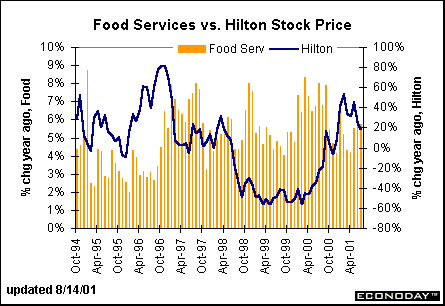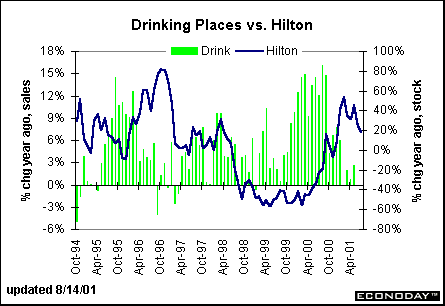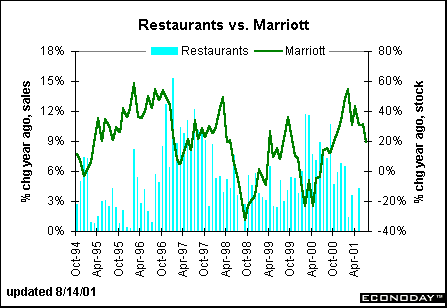A week ago, we indicated that the fundamental analysis of stock prices benefits by including economic indicators as part of the analytical toolbox. We compared key hotels with hotel and lodging payroll employment assuming that payroll employment in the hotel business would rise if revenues and profits were increasing. In turn, this would allow stock price appreciation in this industry. The relationship between stock price changes and payrolls changes wasn't bad, but the relationship didn't explain some of the weakness in the stock price of Hilton, Marriott and Starwood companies in 1998 and 1999.
Besides hotel & lodging payrolls within the employment report, what else could be related to performance in the leisure industry? Retail sales figures were reported on Tuesday and these include figures on the food service industry. The food service industry would be related to hotels in two ways. First, most (if not all) major hotels do incorporate restaurants within their premises. Second, people who are traveling on vacation or business by definition are forced to eat out, rather than at home.
The chart below depicts the relationship between year-over-year changes in food service sales relative to the year-over-year change in the stock price of Hilton Hotels. If you look closely at the chart, you will see a decent relationship between the two series, but not enough to satisfy. The food service sector includes full-scale restaurants, limited service restaurants and drinking places. One would think that these three types of food services would be correlated with the hotel industry.

We decided to break down the food service sector into its component parts and first looked at the relationship between drinking places and hotel stock prices. As you can see in the chart below, the correlation is not obvious between drinking places and Hilton's stock price. We also analyzed stock prices for Marriott and Starwood Resorts, but these weren't correlated closely either.

We then decided to look at the relationship between hotel stock prices and full-scale restaurant sales. The correlation was much improved. Indeed, notice that the relationship holds well through 1998 and 1999. Remember that the hotel and lodging payroll figures didn't hold during this period for Hilton Hotels.
(See Short Take, August 8)

Marriott's stock price shows somewhat more volatility during 1998 and 1999 so it doesn't correlate as well as Hilton during this period. Indeed, the Marriott company doesn't show as close a correlation as Hilton for the entire period, although the payroll data did a better job for Marriott than for Hilton overall.

Starwood Hotels and Resorts appears to behave more like Hilton Hotels and less like Marriott. As a consequence, the restaurant sales figures do a pretty good job in revealing trends in the stock price of this company.

The bottom line? It is useful to look at more than one economic indicator when doing fundamental economic analysis of various companies. It is useful to be a creative thinker in trying to figure out which economic force affects companies or industries. But be careful not to try economic data willy nilly because spurious relationships can exist for extended periods of time.
We're not done with our analysis of the leisure industry! Stay tuned for next week when we go back to the employment data for a better fitting indicator for this industry.
(Do you wonder how we chose these particular companies for analysis? They are listed in Business Week's corporate scoreboard as part of the hotel industry. Historical stock prices were readily available on AOL.)
Evelina M. Tainer, Chief Economist, Econoday
| 